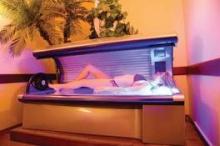Indoor tanning is associated with a fourfold increased risk of melanoma, according to findings published online May 27 in Cancer Epidemiology, Biomarkers & Prevention.
The findings were based on data from the Skin Health Study, a population-based, case-control study of 1,167 cases and 1,101 controls.
Melanoma was 2.9 times more likely to occur in users of high-speed/high-intensity (UVB-enhanced) tanning devices and 4.4 times more likely in users of high-pressure (primarily UVA-emitting) devices, compared with individuals who had never used the devices.
In addition, melanoma was 1.8 and 1.9 times more likely in users of conventional indoor tanning devices and sunlamps, respectively, compared with never users.
The study population included individuals aged 25-59 years who were diagnosed with invasive cutaneous melanoma between July 2004 and December 2007 in Minnesota and who were enrolled in a state cancer registry. Controls were selected at random from the Minnesota state driver’s license list. Study participants completed a self-administered questionnaire and a detailed 1-hour phone interview (Cancer Epidemiol. Biomarkers Prev. 2010 [doi: 10.1158/1055-9965.EPI-09-1249]).
DeAnn Lazovich, Ph.D., of the University of Minnesota, Minneapolis, and colleagues began the Skin Health Study in 2004 in Minnesota, a state with a documented high rate of indoor tanning. The data collected by the researchers included skin, hair, and eye color; presence of moles and freckles; lifetime routine sun exposure; age at which tanning beds were first used; duration and frequency of indoor tanning; and type of tanning device used.
Overall, 63% of individuals with melanoma and 51% of controls reported any indoor tanning. Melanoma risk increased significantly as the frequency of indoor tanning increased. Individuals with melanoma were more than twice as likely as controls to report painful burns resulting from indoor tanning, and they reported significantly more of these painful burns than controls.
The researchers also noted that a dose-response relationship between the number of tanning sessions and the number of melanoma lesions on the trunk was identified in both men and women.
“We did not find lifetime routine sun exposure or sun exposure via recreational outdoor activities or occupations to be associated with melanoma risk,” Dr. Lazovich and associates wrote. “To the extent that sunburns are a marker of intermittent sun exposure, then our results adequately represent the independent effect of indoor tanning use on the risk of melanoma.”
“As dermatologists, we see the horrible price paid for using these devices,” Dr. Allan C. Halpern, chief of dermatology at Memorial Sloan-Kettering Cancer Center, New York, said during a teleconference on May 27 to discuss the study findings. Dr. Halpern was not involved in the study.
“We now know that the total amount of UV exposure in tanning beds over time is important,” Dr. Halpern said. “I’m hopeful that this study is going to be very helpful in the hands of the FDA to further regulate the industry.”
Dr. Halpern said that dermatologists have long understood the importance of educating patients about the dangers of indoor tanning devices, but that misinformation about the risks and benefits of indoor tanning persist.
“I think this study very much strengthens our hand,” he said. Dr. Halpern added that he was encouraged to see the consumer video posted by the FDA earlier this week, which states than any UV indoor tanning device should be avoided.
In 2009, the International Agency for Research on Cancer classified tanning beds as carcinogenic to humans. In 2010, a Food and Drug Administration advisory panel recommended tighter restrictions on the use of indoor tanning devices, but the FDA has yet to issue any guidelines based on these recommendations.
The findings address several limitations of previous studies on this topic, including the ability to control for confounding variables such as sun exposure, the investigators noted.
None of the study authors stated that they had any conflicts of interest to disclose. The study was supported in part by a grant from the American Cancer Society and the National Cancer Institute.



